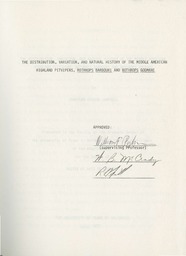
ATTENTION: The works hosted here are being migrated to a new repository that will consolidate resources, improve discoverability, and better show UTA's research impact on the global community. We will update authors as the migration progresses. Please see MavMatrix for more information.
Show simple item record
| dc.contributor.author | Campbell, Jonathan Atwood | |
| dc.date.accessioned | 2019-10-29T20:31:44Z | |
| dc.date.available | 2019-10-29T20:31:44Z | |
| dc.date.issued | 1977 | |
| dc.identifier.uri | http://hdl.handle.net/10106/28760 | |
| dc.description.abstract | Ecological limiting factors, morphological characteristics, and life history data were used to explain the possible origin, dispersal, and present distribution of Bothrops godmani and B. barbouri. Museum specimens were examined in detail and field investigations were carried out from 1973 to 1976 for a period totaling approximately four months. Bothrops barbouri is distributed at elevations above 2400 meters in cloud forest and at higher elevations in mesic fir-pine-oak forests in Guerrero, Mexico. Bothrops godmani is distributed from southeastern Oaxaca, Mexico, to Chiriqu (Province, Panama, at elevations exceeding 1500 meters. This species inhabits a variety of forest types ranging from mesic cloud forests to dry pine-oak forests. A major hiatus, the Nicaraguan Gap, is present in the distribution of B. godmani. Both
species are sympatric with crotalids only on small portions of their range, B. barbouri in the drier parts of its habitat, and B. godmani in some of the more mesic forests in which it occurs. Bothrops barbouri was sexually dimorphic with males having fewer ventrals and proportionally longer tails than females. Maleh godmani generally had more ventrals and subcaudals, proportionally longer tails, and greater body length than females. Ontogenetic variation in scale shape and head and tail proportions where noted for both species. The Meseta Central de Chiapas sample varied significantly from other samples of B. godmani for head to body length relationships. Individual variation in B. godmani was slight between most samples from Nuclear and Isthmian Central America. The Meseta Central de Chiapas sample however was significantly different from all others in having fewer ventrals and fewere pterygoid and dentary teeth. Specimens from this population were distinctively colored and patterned and reached shorter adult lengths. Prey items recorded for h barbouri were Barisia gadovi and rodents. The diet of B. godmani consisted primarily of orthopterans and rodents,
Orthopterans were more frequently eaten by juveniles than by adults; also predation on orthopterans by all size groups increased during the rainy period. Both species appear to be day-active. The number of offspring produced by h barbouri and B. godmani appeared to be few, but young were large compared to female body size. Young of B. godmani are born in the rainy season and a biennial reproductive cycle is strongly inferred for this species. Bothrops godmani reaches maturity within three years. Bothrops barbouri and B. godmani appear to be derived from populations of a common ancestral stock that became isolated from each other by barriers in the Isthmus of Tehuantepec in the Miocene or Pliocene. Samples of B. godmani from Oaxaca and Costa Rica-Panama resembled each other more for primitive characterisitics than they resembled geographically intermediate samples. However these populations do not appear to have differentiated greatly from intermediate populations and probably represent recent invasions, but the population existing on the Meseta Central de Chiapas is so distinctive that a pre-Pleistocene isolation and subsequent differentiation is suggested. The presence of specimens on the Meseta that resemble snakes from the Sierra de los
Cuchumatanes possibly indicates a secondary invasion into the region. It is possible that the two populations have reached a specific level of differentiation. No intergrades were found. It appears that various adaptations (loss of caudal luring, orthopteran predation, reproductive season and cycle, diurnal foraging behavior, and basking by gravid females) are all ecological adjustments related to the invasion of the highlands. | en_US |
| dc.language.iso | en_US | en_US |
| dc.publisher | University of Texas at Arlington Libraries | en_US |
| dc.subject | Poisonous snakes -- Central America | en_US |
| dc.subject | Poisonous snakes -- Mexico | en_US |
| dc.title | The distribution, variation, and natural history of the middle American highland pitvipers, Bothrops barbouri and Bothrops godmani | en_US |
| dc.title.alternative | The distribution, variation, and natural history of the middle American highland pitvipers, Bothrops barbouri and Bothrops godmani | en_US |
| dc.type | Thesis | en_US |
Files in this item
- Name:
- Jonathan Campbell Thesis.pdf
- Size:
- 481.2Mb
- Format:
- PDF
- Description:
- PDF
This item appears in the following Collection(s)
Show simple item record


